70 years of development in Chinese consumption
By Xie Jun and Zhang Hongpei Source:Global Times Published: 2019/9/25 18:38:40 Last Updated: 2019/9/25 23:12:15
Global food, beverage and pet industries have grown alongside the nation’s disposable income
Editor's note:
Consumption in China has changed substantially over the past 70 years, since the country was founded in 1949. Having become a driving force in China's economic development, consumption is set to remain a major supporting pillar as the nation pursues high-quality development and meets people's demands to pursue a better life. The vigorous domestic consumption market has also continuously attracted foreign enterprises. Global Times reporters recently conducted exclusive interviews with representatives from foreign-invested firms in the retail sector, sharing their insights into China's consumption changes.
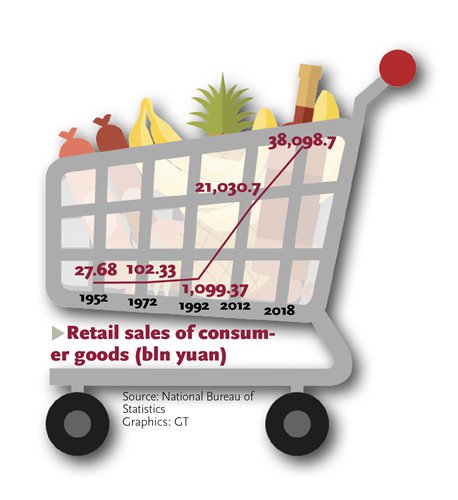
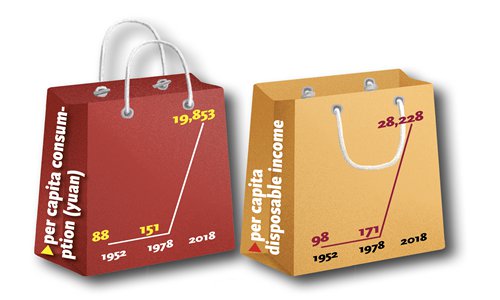
With China's economic development taking great strides over the 70 years since 1949, Chinese people's pockets have been filled with more money to spend. Demand is no longer for physical products alone, but is now also for various services including catering, tourism and culture.
Data from the National Bureau of Statistics (NBS) showed that Chinese disposable income per capita stood at 19,853 yuan ($2790.80), compared with 88 yuan in 1956 and 151 yuan in 1978, when the nation began its reform and opening-up.
Given the steep climb in income, consumption per capita in 2018 was up 19.2 times from the level of 1978.
Total sales in retail soared from 27.7 billion yuan in 1952 to 38.1 trillion yuan in 2018, with an average annual increase of 11.6 percent, according to NBS.
The Coca-Cola Story
Today, Coca-Cola is a commonplace beverage among Chinese people. It is everywhere, and everyone can afford it. Few people would imagine that it was considered a "luxurious" drink when it reentered the Chinese mainland toward the end of the 1970s.
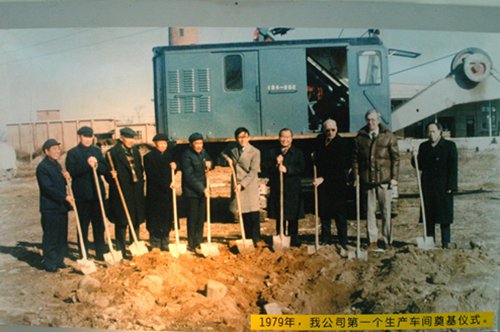
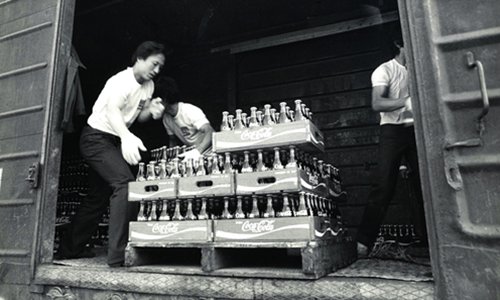
Coca-Cola was sold in the Chinese mainland, and was particularly popular in Shanghai, around the 1920s. Later it exited the mainland market. As the domestic economy slowly but steadily picked up after founding of the People's Republic of China (PRC) in 1949, Coca-Cola's desire to return to China's mainland became urgent.
"Actually, it was a lasting dream for us to return to the Chinese mainland. Before Coca-Cola took action to return to the mainland, it had set up trading companies in Hong Kong and we were constantly discussing the possibility of getting business back to the Chinese mainland. We were hoping to return to China at any time, and in fact we were the first overseas consumer goods company that returned to China after 1949," said Zhang Jiantao, vice president of Greater China, Korea and Mongolia at Coca-Cola.
In January, 1979, Coca-Cola shipped roughly 3,000 cases of its signature beverage in glass bottles by train from Hong Kong to Beijing and Guangzhou, capital of South China's Guangdong Province. This marked the start of the US beverage maker's business expansion into the mainland after the founding of the PRC.
According to Zhang, Coca-Cola can be deemed an index of China's rising consumption power and economic leap over the past 70 years, as it gradually evolved from a luxury item to an ordinary beverage.
"When Coke was first sold in the mainland, it cost about 3-4 yuan per bottle - you can imagine what the proportion of that amount of money was to the average salary at that time, and that's why people considered it as a sort of high-end product. Now each bottle of Coke still costs that much, and the situation now is that everybody can afford it," Zhang told the Global Times.
In 1980, Chinese employees earned 762 yuan on average, according to media reports. In comparison, the average yearly salary reached 68,380 yuan in major enterprises in China in 2018, NBS data showed.
Aside from price, easing restrictions on buying and selling in past years also helped boost consumption. According to Zhang, Coca-Cola was first sold in foreign hotels and Friendship Stores, which mainly served foreigners in the past. It was once very difficult for ordinary Chinese people to enter such stores unless they had a passport to prove that they had been abroad.
Buyers also had to possess a Foreign Exchange Certificate, a kind of foreign exchange voucher issued by the Bank of China in 1980, to shop in certain stores like the places where Coke was sold, so it was at first very inconvenient for domestic consumers to purchase the beverage.
But, certainly the situation has changed significantly over the years. As Chinese people have gained more disposable income and overseas products became more accessible, Coca-Cola's business leapt in the mainland. Coca-Cola has also developed a variety of drinks in China besides Coke.
"Over the years, we have gradually set up 45 plants in the Chinese mainland. The reason that we are building more and more plants here is that we have felt protection from China's legal system, benefits from local policies and rising confidence due to the growth of our business scale in China."
Coca-Cola has accumulatively invested about $13 billion in China so far.
According to Zhang, after dozens of years of development in China, the country has become a market that Coca-Cola can't give up. "No matter how the world's economic and political structure evolves, we still have confidence [in the Chinese market]," he said.
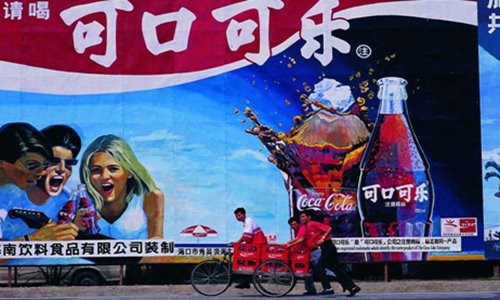
From exotic to everyday
"It was such a luxury to take a bite of chocolate at that time. Such a high-end experience that was treated as a prize," said Brandy Niu, general manager of Pet Nutrition at Mars China, when she recalled the initial period of Mars' entrance to the Chinese market at the end of the 1980s.
From the founding of the PRC until 1978, there was a very limited choice for food. During that time, Chinese people were focused on getting enough food to survive, Niu told the Global Times in a recent, exclusive interview.
"Now Chinese consumers care more about food quality and taste, and look for healthy food; whether it can help maintain a slim body and healthy look," said Niu.
She noted that Dove chocolate, a Mars product, has become affordable for Chinese consumers, who are now wondering if its dark chocolate type could be healthier.
As people change alongside society's progress, they are not limited to spending money on daily necessities. Now, Chinese people are also expanding their expenditure to spiritual and cultural levels, as well as investing money in pets.
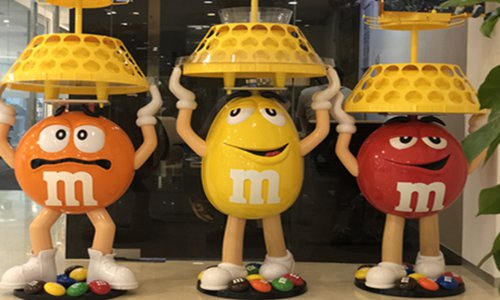
There were very few people who bought dog food or cat food when Mars imported it as it entered the Chinese market, as most people thought pet food was only leftovers, said Niu. Now, purchasing pet food and pet medical care is popular.
According to a pet industry white paper, the scale of China's pet market reached 170.8 billion yuan in 2018, and the figure is expected to break the 250 billion-yuan mark in 2022 based on the compound annual growth rate of over 34 percent during the 2012-17 period.
Witnessing China's flourishing pet market, Mars will continue to invest in China to grow alongside the country's huge consumption. "One thing is quite sure: there is nothing that can stop Chinese consumers from pursuing a happier and better life," said Niu.
Mars invested $100 million in a new facility in North China's Tianjin at the beginning of this year, to build an ecosystem around pet health. "We are betting on the vigorous economy in the Chinese market and want to witness the country's further changes in the future," she added.
Consumption in China has changed substantially over the past 70 years, since the country was founded in 1949. Having become a driving force in China's economic development, consumption is set to remain a major supporting pillar as the nation pursues high-quality development and meets people's demands to pursue a better life. The vigorous domestic consumption market has also continuously attracted foreign enterprises. Global Times reporters recently conducted exclusive interviews with representatives from foreign-invested firms in the retail sector, sharing their insights into China's consumption changes.


Graphics: GT
With China's economic development taking great strides over the 70 years since 1949, Chinese people's pockets have been filled with more money to spend. Demand is no longer for physical products alone, but is now also for various services including catering, tourism and culture.
Data from the National Bureau of Statistics (NBS) showed that Chinese disposable income per capita stood at 19,853 yuan ($2790.80), compared with 88 yuan in 1956 and 151 yuan in 1978, when the nation began its reform and opening-up.
Given the steep climb in income, consumption per capita in 2018 was up 19.2 times from the level of 1978.
Total sales in retail soared from 27.7 billion yuan in 1952 to 38.1 trillion yuan in 2018, with an average annual increase of 11.6 percent, according to NBS.
The Coca-Cola Story
Today, Coca-Cola is a commonplace beverage among Chinese people. It is everywhere, and everyone can afford it. Few people would imagine that it was considered a "luxurious" drink when it reentered the Chinese mainland toward the end of the 1970s.

Representatives from Coca-Cola attended the groundbreaking ceremony of its first production workshop in Beijing in 1979. Photo: Courtesy of Coca-Cola

Cases of Coca-Cola were unloaded from trains when they were shipped to Beijing from Hong Kong in 1979. Photo: Courtesy of Coca-Cola
Coca-Cola was sold in the Chinese mainland, and was particularly popular in Shanghai, around the 1920s. Later it exited the mainland market. As the domestic economy slowly but steadily picked up after founding of the People's Republic of China (PRC) in 1949, Coca-Cola's desire to return to China's mainland became urgent.
"Actually, it was a lasting dream for us to return to the Chinese mainland. Before Coca-Cola took action to return to the mainland, it had set up trading companies in Hong Kong and we were constantly discussing the possibility of getting business back to the Chinese mainland. We were hoping to return to China at any time, and in fact we were the first overseas consumer goods company that returned to China after 1949," said Zhang Jiantao, vice president of Greater China, Korea and Mongolia at Coca-Cola.
In January, 1979, Coca-Cola shipped roughly 3,000 cases of its signature beverage in glass bottles by train from Hong Kong to Beijing and Guangzhou, capital of South China's Guangdong Province. This marked the start of the US beverage maker's business expansion into the mainland after the founding of the PRC.
According to Zhang, Coca-Cola can be deemed an index of China's rising consumption power and economic leap over the past 70 years, as it gradually evolved from a luxury item to an ordinary beverage.
"When Coke was first sold in the mainland, it cost about 3-4 yuan per bottle - you can imagine what the proportion of that amount of money was to the average salary at that time, and that's why people considered it as a sort of high-end product. Now each bottle of Coke still costs that much, and the situation now is that everybody can afford it," Zhang told the Global Times.
In 1980, Chinese employees earned 762 yuan on average, according to media reports. In comparison, the average yearly salary reached 68,380 yuan in major enterprises in China in 2018, NBS data showed.
Aside from price, easing restrictions on buying and selling in past years also helped boost consumption. According to Zhang, Coca-Cola was first sold in foreign hotels and Friendship Stores, which mainly served foreigners in the past. It was once very difficult for ordinary Chinese people to enter such stores unless they had a passport to prove that they had been abroad.
Buyers also had to possess a Foreign Exchange Certificate, a kind of foreign exchange voucher issued by the Bank of China in 1980, to shop in certain stores like the places where Coke was sold, so it was at first very inconvenient for domestic consumers to purchase the beverage.
But, certainly the situation has changed significantly over the years. As Chinese people have gained more disposable income and overseas products became more accessible, Coca-Cola's business leapt in the mainland. Coca-Cola has also developed a variety of drinks in China besides Coke.
"Over the years, we have gradually set up 45 plants in the Chinese mainland. The reason that we are building more and more plants here is that we have felt protection from China's legal system, benefits from local policies and rising confidence due to the growth of our business scale in China."
Coca-Cola has accumulatively invested about $13 billion in China so far.
According to Zhang, after dozens of years of development in China, the country has become a market that Coca-Cola can't give up. "No matter how the world's economic and political structure evolves, we still have confidence [in the Chinese market]," he said.

Coca-Cola's 1990s advertisement read, "Please drink Coca-Cola." Photo: Courtesy of Coca-Cola
From exotic to everyday
"It was such a luxury to take a bite of chocolate at that time. Such a high-end experience that was treated as a prize," said Brandy Niu, general manager of Pet Nutrition at Mars China, when she recalled the initial period of Mars' entrance to the Chinese market at the end of the 1980s.
From the founding of the PRC until 1978, there was a very limited choice for food. During that time, Chinese people were focused on getting enough food to survive, Niu told the Global Times in a recent, exclusive interview.
"Now Chinese consumers care more about food quality and taste, and look for healthy food; whether it can help maintain a slim body and healthy look," said Niu.
She noted that Dove chocolate, a Mars product, has become affordable for Chinese consumers, who are now wondering if its dark chocolate type could be healthier.
As people change alongside society's progress, they are not limited to spending money on daily necessities. Now, Chinese people are also expanding their expenditure to spiritual and cultural levels, as well as investing money in pets.

M&M's, a Mars chocolate brand, advertise outside the Mars China office in Beijing. Photo: Zhang Hongpei/GT
There were very few people who bought dog food or cat food when Mars imported it as it entered the Chinese market, as most people thought pet food was only leftovers, said Niu. Now, purchasing pet food and pet medical care is popular.
According to a pet industry white paper, the scale of China's pet market reached 170.8 billion yuan in 2018, and the figure is expected to break the 250 billion-yuan mark in 2022 based on the compound annual growth rate of over 34 percent during the 2012-17 period.
Witnessing China's flourishing pet market, Mars will continue to invest in China to grow alongside the country's huge consumption. "One thing is quite sure: there is nothing that can stop Chinese consumers from pursuing a happier and better life," said Niu.
Mars invested $100 million in a new facility in North China's Tianjin at the beginning of this year, to build an ecosystem around pet health. "We are betting on the vigorous economy in the Chinese market and want to witness the country's further changes in the future," she added.